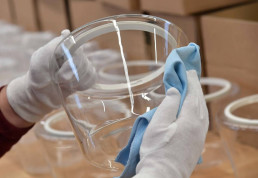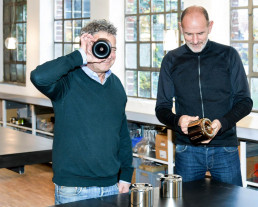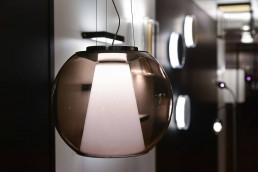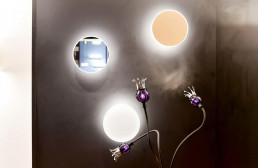Die Tüftler
Architektonische Leuchten aus Metall, gefertigt in Handarbeit – damit begann einst die Erfolgsgeschichte von serien.lighting. Heute stattet der hessische Lichtspezialist internationale Projekte aus.
von Anna Moldenhauer | 07.02.2020
Die Wurzeln von serien.lighting liegen in den Achtzigern: Manfred Wolf und Jean-Marc da Costa lernten sich beim Designstudium an der Offenbacher Hochschule für Gestaltung kennen. Beide hatten unabhängig voneinander entschieden eine Leuchte zu entwerfen – über die Faszination für Licht entwickelte sich schnell eine Freundschaft. Für den weiteren gemeinsamen Weg ergänzten sich ihre Erfahrungen: Jean-Marc da Costa brachte geprägt durch den Beruf seines Vaters, eines Architekten, architektonisches Verständnis ein. Manfred Wolf handwerkliches Geschick und viele Kenntnisse aus der Metallverarbeitung. Als Studenten konnten sie die Werkstatt nutzen, in der Wolfs Vater und Großvater Koffer- und Taschenbeschläge herstellten. Dort hatten sie ideale Voraussetzungen, um in aller Ruhe an ihren Entwürfen zu tüfteln. “Wir konnten Metall biegen, verschweißen, verformen und einen eigenen Werkzeugbau entwickeln”, so Manfred Wolf. An kreativen Ideen für Leuchten mangelte es beiden nicht – Entwürfe wie “LIFT”, “REFLEX”, “QUADRAT” oder “STATUS” stammen aus dieser Zeit. Puristische, ästhetische Leuchten, die die Funktion und das Licht selbst in den Fokus rücken. In ihrer Entstehung mitten in den expressiven Achtzigern, auf dem Höhepunkt der Postmoderne, fast eine Provokation. Mit ihrem Wagemut setzte serien.lighting, damals noch unter den Namen “Serien Raumleuchten” ein klares Statement: Trends hinterherzulaufen ist nicht ihre Sache. “Bei der Frage ob es einen Bedarf an dem Produkt gibt oder nicht vertraue ich lieber meinem Bauchgefühl”, so Jean-Marc da Costa. Wichtig dabei: Keine übereilten Schritte. Der kreative und handwerkliche Prozess braucht nun mal seine Zeit, damit am Ende ein Produkt stehen kann, dass auch hohen Anforderungen an das Zusammenspiel aus Technik, Design und Funktion entspricht.
Diese Überzeugung haben sich da Costa und Wolf bewahrt – von ihrem Durchbruch mit einer Ausstellung der ersten Produkte im Kölner Möbelhaus Martin Stoll zur imm cologne 1985, bis heute. Mittlerweile stattet serien.lighting mit einem Team von 40 Mitarbeitern internationale Projekte aus. “Wir sind langsam, aber stetig gewachsen”, resümiert Jean-Marc da Costa. Der Standort in Rodgau ist geblieben. Die Räume in dem charmanten Backsteingebäude, in dem bereits Manfred Wolfs Großvater werkelte, wurden entsprechend angepasst: Weiß getünchte Wände, viel Glas und ausreichend Platz, um die Neuheiten auszustellen. Mit den Jahren kamen noch zwei weitere Hallen für die Fertigung und Logistik in Rodgau dazu. Neu im Programm ist aktuell “REFLEX²“, eine Weiterentwicklung der kubischen Erfolgsleuchte “REFLEX”, mit der für serien.lighting der Weg einst begann. Das Licht der LEDs wird nach oben in die leuchteneigene Reflektorfläche gestrahlt und geht von dort aus in den Raum zurück, ohne dass die Leuchtquelle direkt sichtbar ist. Zur Light + Building 2020 wird serien.lighting auch Versionen als Stehleuchte und Wandleuchte vorstellen. Ebenfalls frisch im Sortiment ist “DRAFT“, deren Kombination aus mundgeblasener Glaskugel und konischem Innenreflektor einen eleganten Kontrast erzeugt. Auch hier ist die Leuchtquelle nicht zu sehen, da sie sich tief im Innenreflektor verbirgt.
Unter Kontrolle
Die Leuchten von serien.lighting haben eines gemeinsam: Einen hohen Wiedererkennungswert. Von “POPPY“, deren Leuchtenkopf sich wie eine Blüte öffnet, bis zu “ZOOM”, eine zum Kreis geschlossene Scherengitterkonstruktion. Inspiration für die Pendelleuchte “ZOOM“, die sich im Durchmesser stufenlos verstellen lässt, lieferte das Scherengitter einer Geldbörse. Praktisch gedacht und intuitiv verständlich – zwei weitere Merkmale der Leuchten von serien.lighting. Den Nutzer verlieren da Costa und Wolf im kreativen Prozess nie aus den Augen, überprüfen die Handhabung bis in das kleinste Detail. Erst wenn die Produkte im Haus zur Serienreife gebracht sind, wird die Produktion an ausgewählte Fachbetriebe vergeben. Endmontage und Endkontrolle geschieht dann wieder in den eigenen Räumen in Rodgau. Die Qualitätskontrolle hat für serien.lighting den höchsten Stellenwert. “Die würden wir nie aus der Hand geben”, so Jean-Marc da Costa. Auch bei der Zusammenarbeit mit externen Designern wie Benjamin Hopf, Next Space oder Yaacov Kaufman ist der finale serien.lighting Schliff den beiden wichtig. “Die Leuchten sollen vom ersten Tag so aussehen, dass sie Bestand haben”, so da Costa. Beständig sein, wenn die Zeiten sich ändern und die Herausforderungen wachsen, dass schafft serien.lighting nun schon seit über 36 Jahren. Auch wenn die Umstellung der Technologie, wie von der Halogenlampe zum LED-Leuchtmittel, nicht immer einfach war. Viele der zeitlosen Entwürfe waren um die Leuchtmittel herum entstanden, nun wurden umfassende technische Neuentwicklungen nötig. “Die Weiterentwicklungen und alle neuen Modelle mit LED müssen das hohe Maß an Perfektion erfüllen, das man von serien.lighting gewohnt ist”, so Jean-Marc da Costa.
Kompetenz im Licht
Kompromisslos bis in das Detail gedacht – eine Einstellung, die nicht nur für den Endkunden funktioniert, sondern vor allem auch für Architekten und Planer, mit denen serien.lighting regelmäßig zusammenarbeitet. Von Restaurants und Hotels über Universitäten und Banken, bis zu Synagogen und Museen reicht die Bandbreite der Projekte, für die die beiden Produktdesigner bereits Leuchten modifiziert oder projektbezogene Sonderlösungen entwickelt haben. Eine gemeinsame Sprache auf Augenhöhe ist Jean-Marc da Costa und Manfred Wolf hierbei wichtig. Zwischen Ideenentwicklung und Montage soll im Austausch ein kreativer Prozess angestoßen werden, an dessen Ende eine individuelle Lösung steht, die langfristig funktioniert. Wie die Arbeitsleuchte “SNAKE”, die mit schlanker Form und konzentriertem Licht den Anforderungen der Universitätsbibliothek Freiburg optimal angepasst wurde. Dank der Kombination aus technischem Minimalismus und hoher Qualität lassen sich die Leuchten in viele Architekturen harmonisch einfügen. Zum Beispiel in das Goethequartier in Offenbach, das größte Neubauprojekt der Stadt mit 327 Wohnungen: Mit von der Partie werden zahlreichen Leuchten von serien.lighting sein – von den Treppenhäusern bis zu den Bädern. “Keine Dekoobjekte, sondern funktionales Design, das auch im Alltag besteht”, so Manfred Wolf. Die langlebigen Lichtlösungen bieten so ganz selbstverständlich einen Beitrag zur Nachhaltigkeit. “Wir entwickeln trotz allen Marktdrucks stets jedes Produkt zu Ende, damit es auch auf lange Sicht überzeugt”, so Jean-Marc da Costa. Dazu gehört für serien.lighting eine verständliche, handwerklich gedachte Steuerung, die auch mit modernster Technik nah am Nutzer ist. Mit großer Faszination für das Licht und Freude am Tüfteln neuer Ansätze leuchten Jean-Marc da Costa und Manfred Wolf nun in eine neue Dekade – passend zu ihrem Slogan “Living the light”.
Link zum Originalartikel auf stylepark.com
Fotos: Joerg Puchmüller, Stylepark
puchmueller.de #joergphotographie







